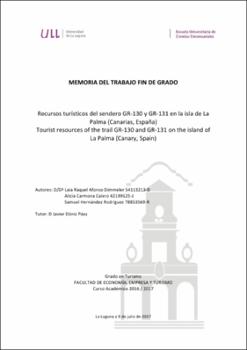Recursos turísticos del sendero GR-130 y GR-131 en la isla de La Palma (Canarias, España)
Fecha
2017Resumen
El turismo es un sistema complejo compuesto por diferentes elementos. Los recursos son claves
para elaborar productos turísticos. El senderismo es una actividad deportiva no competitiva que
explota el patrimonio natural y cultural por donde discurre. La Palma es pionera en este tipo de
actividades y por ello se ha elegido para realizar este TFG. Se ha seleccionado el GR 130-GR
131 ya que cubre gran parte de la superficie insular. El objetivo del TFG es inventariar los
atractivos en los diferentes tramos del GR en la isla. La metodología empleada es la clasificación
de inventarios propuesto por la OEA. Los principales resultados muestran que hay una gran
diversidad de atractivos, predominando los naturales y realizaciones contemporáneas en el
100% de los tramos frente al folclore que solo está presente en el 0,9% de los mismos. En
general no se explotan bien los atractivos por falta de contenidos. Tourism is an intricate system formed by different factors. The resources are key elements when
it comes to create tourism products. Hiking is a non-competitive sport activity, developed
throughout natural and cultural heritage. La Palma leads the way in this kind of activity, and this is
the reason why it has been chosen for this final project. The project is focused on GR 130-GR
131, because these great routes almost embrace the whole island surface area. The aim of the
survey is to establish an inventory of the main tourist attractions on each trail section in this
island. The methodology used is the OAS tourism resources classification. The results show the
great range of attractions, prevailing natural resources and contemporary manifestations in a
100% of the trail segments, in contrast with folklore, which is present only in a 0,9%. Basically the
attractions are not being successfully exploited due to a lack of content.





